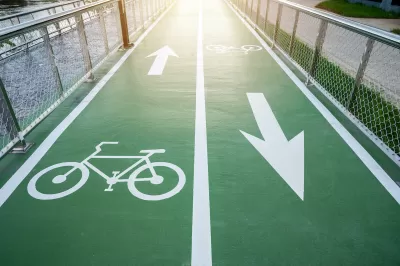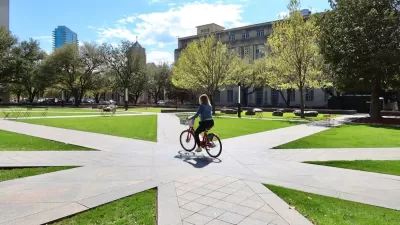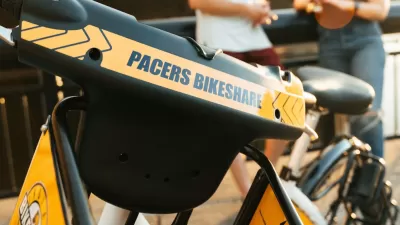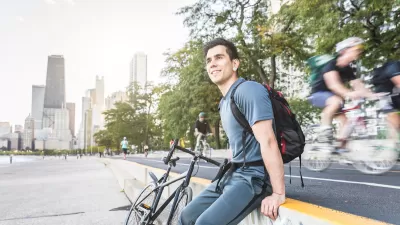Getting more people on bikes requires safe, comfortable bike infrastructure and connectivity to transit.

May is National Bike Month, and cycling advocates around the country are both celebrating recent victories and calling attention to the work that remains to make U.S. bike infrastructure safe and comprehensive. While some cities have made significant strides in building out their protected bike lane networks and making it easier to connect biking with other transit options, others continue to lag behind. Despite a plethora of Vision Zero pledges, cyclist and pedestrian deaths remain at all-time highs in many parts of the country.
Which cities rate highest for bike infrastructure? Where do bike commuters use facilities the most? Where can you get a government subsidy for buying an e-bike? Find out below!
U.S. cities with highest 2023 PeopleForBikes bike scores:
- Provincetown, Massachusetts
- Crested Butte, Colorado
- Blue Diamond, Nevada
- Murdock, Nebraska
- Ashland, Wisconsin
- Jackson, Wyoming
- Davis, California
- Aspen, Colorado
- Shorewood, Wisconsin
- Ankeny, Iowa
Large U.S. cities with highest 2023 PeopleForBikes bike scores:
- Minneapolis, Minnesota
- San Francisco, California
- Seattle, Washington
- Philadelphia, Pennsylvania
- Portland, Oregon
- New York City, New York
- St. Paul, Minnesota
- Washington, D.C.
- Milwaukee, Wisconsin
- Detroit, Michigan
U.S. cities with the highest percentage of bike commuters*
- Portland, Oregon: 6.3%
- Washington, D.C.: 5%
- Minneapolis, Minnesota: 3.9%
- San Francisco, California: 3.1%
- New Orleans, Louisiana: 2.9%
- Seattle, Washington: 2.8%
- Philadelphia, Pennsylvania: 2.6%
- Tucson, Arizona: 2.5%
- Oakland, California: 2.3%
- Denver, Colorado: 2.2%
*This list is based on 2019 data, but conditions in some cities have changed since then.
U.S. cities with e-bike subsidies*
- Alameda County, California
- Berkeley, California
- Contra Costa County, California
- Healdsburg, California
- Los Angeles County, California
- Monterey County, California
- Orange County, California
- Pasadena, California
- Redding, California
- Riverside County, California
- San Bernardino County, California
- San Francisco, California
- Santa Barbara, California
- Santa Clara, California
- Santa Cruz, California
- Boulder, Colorado
- Denver, Colorado
- Atlanta, Georgia
- Bloomington, Indiana (on hold)
- Raleigh, North Carolina
- Columbus, Ohio
- Ashland, Oregon
- Eugene, Oregon
- Austin, Texas
- Washington, D.C.
Additionally, Colorado, Connecticut, Hawaii, Rhode Island, and Vermont offer statewide incentives, and bills supporting e-bike rebates are making their way through more state legislatures.
*Some smaller incentive programs exist that may not be included in this list.

Trump Administration Could Effectively End Housing Voucher Program
Federal officials are eyeing major cuts to the Section 8 program that helps millions of low-income households pay rent.

Planetizen Federal Action Tracker
A weekly monitor of how Trump’s orders and actions are impacting planners and planning in America.

Ken Jennings Launches Transit Web Series
The Jeopardy champ wants you to ride public transit.

Crime Continues to Drop on Philly, San Francisco Transit Systems
SEPTA and BART both saw significant declines in violent crime in the first quarter of 2025.

How South LA Green Spaces Power Community Health and Hope
Green spaces like South L.A. Wetlands Park are helping South Los Angeles residents promote healthy lifestyles, build community, and advocate for improvements that reflect local needs in historically underserved neighborhoods.

Sacramento Plans ‘Quick-Build’ Road Safety Projects
The city wants to accelerate small-scale safety improvements that use low-cost equipment to make an impact at dangerous intersections.
Urban Design for Planners 1: Software Tools
This six-course series explores essential urban design concepts using open source software and equips planners with the tools they need to participate fully in the urban design process.
Planning for Universal Design
Learn the tools for implementing Universal Design in planning regulations.
Heyer Gruel & Associates PA
Ada County Highway District
Institute for Housing and Urban Development Studies (IHS)
City of Grandview
Harvard GSD Executive Education
Toledo-Lucas County Plan Commissions
Salt Lake City
NYU Wagner Graduate School of Public Service






























